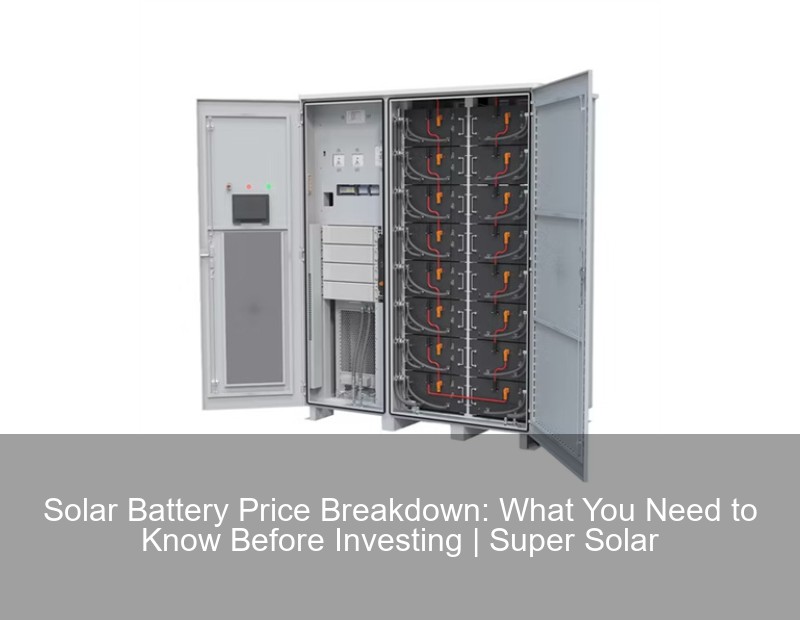Solar Battery Price Breakdown: What You Need to Know Before Investing

Why Solar Battery Prices Are Like Smartphone Upgrades (But Better)
Let’s face it – when you hear "solar battery price," your first thought might be: *"Will this leave my wallet as empty as my phone battery at 3 PM?"* Good news – the solar storage market isn’t just for eco-millionaires anymore. In 2023, the average residential solar battery system costs between $12,000 and $20,000 installed. But here’s the kicker: prices have dropped 40% since 2018. Think of it like buying the latest iPhone… except this gadget actually saves you money long-term.
The Nuts and Bolts: What Determines Solar Battery Costs?
- Capacity: Measured in kilowatt-hours (kWh), it’s your energy piggy bank. A 10kWh Tesla Powerwall? About $14,500. A 5kWh system? You’re looking at $8K-ish.
- Chemistry Class: Lithium-ion batteries rule the market (90% of new installations), but flow batteries are the new kids on the block for commercial use.
- Installation Drama: Permitting fees, electrician rates, and whether your utility company plays nice with solar. Pro tip: Hawaii’s solar hookup fees are 3x higher than Texas’. Aloha, indeed.
Real-World Math: When Do Solar Batteries Pay Off?
Meet Sarah from Arizona – she bought a 13kWh LG Chem system for $16,000. With SRP’s time-of-use rates, she slashed her peak-hour electricity costs by 82%. At this rate, her solar battery price pays for itself in 7 years. Not bad for someone who still uses “Ctrl+Alt+Del” to fix Wi-Fi issues.
Industry Secrets Your Installer Won’t Tell You
- The 30% Tax Credit Trick: Uncle Sam’s Inflation Reduction Act gives you back 30% of battery costs if paired with solar panels. That $20k system? Suddenly $14k.
- Virtual Power Plants (VPPs): California’s Powerwall users earned $1,250/year selling stored energy back during grid emergencies. Basically, your basement becomes a mini power station.
- Battery Stacking: Mix and match brands? Not so fast. Tesla + Enphase = tech support hell. Stick with one ecosystem unless you’re into electrician speed-dialing.
The Future Is Charging (Literally)
2024’s big trend? Bidirectional EV batteries. Ford’s F-150 Lightning can power your home for 3 days – effectively making your truck a 131kWh battery on wheels. At $59,000 for the vehicle, that’s cheaper per kWh than most home systems. Who needs a generator when you’ve got a pickup?
Watt’s Next in Solar Storage?
- Graphene Supercapacitors: MIT’s prototype charges 100x faster than lithium-ion. Lab rats say “commercial viability by 2028.”
- Second-Life Batteries: Nissan now repurposes old EV batteries into home storage units at 60% of new battery costs. Take that, landfill!
- Blockchain Energy Trading: Brooklyn microgrid users already swap solar credits peer-to-peer. Your neighbor’s excess sunshine could charge your Tesla tomorrow.
Solar Battery Price Wars: Who’s Winning?
Tesla might dominate headlines, but Chinese giants like BYD and CATL are slashing prices through vertical integration. Their latest 10kWh systems? $6,500 before incentives. Meanwhile, Europe’s Sonnen charges premium prices for cybersecurity-focused systems – because even hackers want your stored sunlight.
Fun fact: A German study found solar + storage users save more on energy bills than those with panels alone. But 23% of participants named their battery systems – “Voltron” and “Sunny D” were crowd favorites.
Pro Mistakes to Avoid
- Ignoring Depth of Discharge (DoD): Using 100% of a battery’s capacity murders its lifespan. 80-90% DoD is the sweet spot.
- Forgetting the “Software Tax”: Some systems require $300/year subscriptions for optimal performance. It’s like buying a printer then discovering ink costs more than caviar.
- Overlooking Climate Needs: Lithium-ion hates extreme cold. Alaskans should consider nickel-iron batteries – they’re basically the Yeti coolers of energy storage.
So, What’s the Catch?
While solar battery prices keep falling, installation bottlenecks are real. The U.S. needs 50,000 more certified solar technicians by 2025. Some homeowners wait 6 months for installs – longer than planning a Kardashian wedding. But with utilities raising rates faster than TikTok trends, the math keeps getting better for storage adopters.
Consider this: Australia’s battery adoption rate jumped 400% after 2022’s catastrophic bushfires. When the grid fails, solar storage isn’t just about savings – it’s about keeping Netflix running during apocalypse movie marathons.